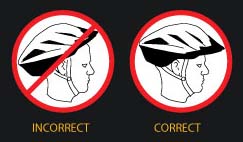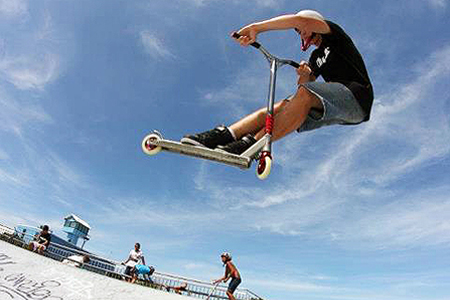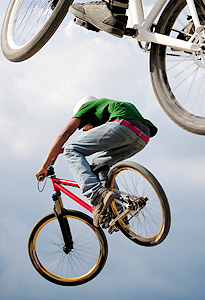Bike Safety
National Light Up! Campaign
As many as 25% of bicycle trips occur after 6pm.
During winter most of the commuter trips and half of all trips will require working bike lights.
Fatalities in night time or semi darkness often involve riders without lights or with inadequate lighting.
A 2006 study suggests that fewer than a quarter of bicycle collisions occur during dusk, dawn and darkness, however the injuries sustained in these collisions are more severe than those in daylight.
Traffic regulations require a flashing or steady white light at the front and a flashing or steady red light at the rear that is clearly visible for at least 200 metres from the bicycle. The RCTA strongly recommends that the main lights be fitted properly to the bike, and not strapped to helmets or backpacks where they are far less effective.
Change the batteries in your lights twice a year
- Fit fresh batteries to your bike lights now
- Buy lights if you don't already have them
- Upgrade any lights that are more than two years old
Even the best equipped riders are more vulnerable in traffic than vehicle drivers.
Riding defensively and scanning the road can improve your safety.
Learning how to share the road safely could save your life.
Laws and penalities
Under NSW legislation bicycles and scooters are considered to be vehicles.
A bicycle means a vehicle with one or more wheels that is built to be propelled by human power through a belt, chain or gears ( whether or not it has an auxiliary motor ) and includes a pedicab, penny-farthing, scooter, tricycle and unicycle.
As such, cyclists are required to obey the road rules, including stopping at red lights or Stop signs. Giving way as indicated by signage and giving hand signals when changing directions. Just as cyclists have responsibilities when using the road system, they also have the right, like other vehicles, to use the road and be shown courtesy and care by other road users.
Cyclists also have some special rights, which include,
Riding two abreast, no more than 1.5m apart Travelling to the front of a line of traffic on the left hand side of the stopped vehicles Travelling in BusLanes and Transit Lanes, but not in Bus Only Lanes. Travelling on the footpath where indicated by signage. Cycling on the footpath if the cyclist is less than 12 years old. An adult, who is riding in a supervisory capacity of a cyclist less than 12 years old, may also ride with the cyclist on the footpath. Turning right from the left hand lane of a multi-lane roundabout with the proviso the cyclists must give way to exiting traffic.
To be a legal road vehicle during the day, a bicycle must have:
At least one working brake. Either a bell or horn fitted to the bike, within reach and in working order.
To be a legal road vehicle at night, a bicycle must have:
- Lights fitted and in use when riding at night - a steady or flashing white light that is clearly visible for at least 200 metres and a flashing or steady red light that is clearly visible for at least 200 metres from the rear of the bike.
- A red rear reflector that is clearly vivible for 50 metres when light is projected onto it by a vehicle's headlight on low beam.
It is compulsory to wear an approved helmet correctly when riding a bike. This applies to all cyclists, regardless of age, including children on bicycles with training wheels and any child being carried as a passenger on a bike or in a trailer. Approved helmets are marked with an Australian Standard Approved Notification (either red or black).
A helmet, when fitted correctly, can reduce the risk of head/brain injury by up to 85 percent. A helmet that is not fitted correctly does not provide this protection.
Children have little or no sense of danger. They are extremely vulnerable when playing and riding near roads and driveways. Extra care needs to be taken to ensure their safety and encourage road safety education.
Failing to obey road or bicycle rules may result in a fine. For more information on this, click on the following link: http://www.rta.nsw.gov.au/roadsafety/bicycles/index.html © Roads and Traffic Authority (NSW)
Carrying bicycles on motor vehicles
Roof rack
If you carry a bicycle on the roof of your car, you should use a dedicated attachment fitted to a roof rack. Before setting off on your journey, you must ensure all the connections are secure . The bicycle to the attachment, the attachment to the roof rack, and the roof rack to the car. As these can work loose during travel, you should check them at regular intervals during the journey. When driving with a bicycle on the roof, take extra care in windy conditions or high wind areas, on winding roads and when approaching places with height restrictions, such as car parks.
Bicycle rack
If you carry a bicycle on the rear of your vehicle you must use a suitable bike rack, which is usually attached to the towbar, boot, or spare tyre on some 4 wheel drive vehicles. Warning: Bike racks are designed to be fitted directly to the vehicle and not to trailer/caravan or other towed equipment. Watch the exhaust - particularly with ladies bikes, as the exhaust heat will melt the tyre and tube, and potentially cause a fire.
Guidelines for using a bike rack attached to the rear of your vehicle
Make sure the bike rack is strong enough to carry the bikes and is securely attached. Each rack has a load rating, which is important to not exceed. It is important to always fit the largest and heaviest bicycle closest to the vehicle, with the smallest and lightest bicycle furtherest from the vehicle.
Make sure the bike rack and it's load does not project excessively behind the rear of the vehicle or protrude more than 150mm beyond the extreme width of either side of the vehicle.

'A' must not be more than 1200mm
'B' must not be more than 60% of the wheelbase
'C' must not be more than 150mm
Make sure the vehicle number plate is clearly visible. If the number plate is obscured you must fit a special 'bike plate' which is a smaller copy of the vehicle plate. This can be from any Motor Registry. Note that the bike rack plate may only be fitted to a bicycle rack that is attached to a motor vehicle. Hand painted plates are not acceptable.
Make sure the bike rack number plate is securely attached and that it's top edge is nomore than 1300mm above the ground.
Make sure the bicycle rack and bicycles do not obscure the vehicle lights(including the centre mounted brake light) and indicators. If any light/s are obscured you must attach an additional set of lights at the rear of the bicycles. Also, if using the rack at night, you must fit one or more number plate lights to illuminate the bike plate if fitted. These lights are available at automotive accessory outlets and bike shops.

If the vehicle is involved in a crash, you may not be insured for any damage done to bikes being carried at the time. Check with your Insurance company to see whether they cover the items that are temporally attached to the vehicle.
Penalities apply if:
The bicycle rack or any bicycle fitted to it obscures any light (including the centre - mounted stop light) or the number plate and is not fitted with an additional set of lights and number plate. The bike rack, with or without bicycle/s, creates a dangerous protrusion to either side or to the rear of the vehicle. All the above information is good practice, and a requirement of the LAW in NSW. NOTE: None of the bike racks will offer total security against theft, even with the addition of good quality locks.
Helmets and safety gear
You only have one head, so why pay more for what you put on your feet than you put on your head
Helmets
A helmet, when fitted correctly, can reduce the risk of head/brain injury by up to 85 percent. A helmet not worn correctly does not provide enough protection. By law, you must wear an approved bicycle helmet while on a bicycle or scooter in NSW- not only on the road, cycling paths and skate parks, but all public places.
Approved helmets are marked with an Australian Standard Approved notification.
The Australian Road Rules clearly demand that a bicycle helmet must meet the Australian / New Zealand Standards. The AS/NZ 2063 Standard does not recognise any other standard helmet from any other country. Accordingly, only helmets that meet and carry the AS/NZ Standards approval are permitted for use on Australian roads - including road races conducted under the auspices of Cycling Australia and its affiliates.


There are four types of helmets:
Soft shell - a foam EPS shell with a fabric cover.
Micro shell - a foam EPS shell with a thin plastic cover.
Hard shell - a foam EPS shell with a thicker plastic cover.
In-mould shell - meaning the outer shell is permanently fused with the foam EPS liner during moulding - more expensive, but stronger and lighter.
The hard shell is better for children as the helmet can take more rough treatment than the other types. The Foam is used for energy management in a helmet, and EPS is the choice for most helmets. The ideal foam would be stiffer in hard impacts, softer in light impacts, light, cheap, and reliable to manufacture and easy to ventilate.
EPS: Expanded Polystyrene
EPP: Expanded Polypropylene. (EPP is a multi impact foam, and more expensive)
The helmet should fit comfortably and securely on the head when the straps are fastened. The straps should not be twisted and should not cover the ears. When done up correctly, the straps should provide a snug fit over the ears and under the chin. Make sure the helmet isn't too heavy for young children (they might have to wear it for a few hours).
Visibility: Choose a bright coloured helmet so other road users can see you.
Visor: A visor will help protect your eyes and face against the sun.
Weight: A light helmet will be comfortable over long periods of time.
Ventilation: Will the helmet keep your head cool on a hot day.
Aerodynamics: Important to sports people who compete.
Cost: Usually the extra dollars buy comfort, looks, increased aerodynamics, and less weight.
Helmets only work once - The helmet should be replaced if:
- It's been dropped onto a hard surface or involved in an accident.
- You see any cracks in the foam.
- The straps look worn or frayed.
If you are cycling with a passenger on a tandem, tag-along or bicycle trailer, your passenger must also wear an approved bicycle helmet.
Remember, a helmet will not stop you having a crash.
Your behaviour is the most important safety factor. make sure you abide by all the rules of the road and path, and ride safely. The Australian Helmet Standard is recognised as one of the strongest in the world.
Clothing
To make it easier for other road users to see you, wear bright clothing during the day and reflective clothing at night. If you have no reflective gear for night riding, a plain white t-shirt is the next best thing.
Lights and reflectors
When you ride at night, there must be a white light on the front of the bike and a red light and red reflector at the back of the bike. Both the lights and the reflector should be clearly visible to other road users.
Horns and bells
Bicycles in NSW must be fitted with a working horn or bell to help sound a warning to other cyclists or pedestrians.
Brakes
The bike must also be fitted with at least one working brake.
General
Remember, it just isn't possible to foresee every dangerous scenario you might encounter on a bike. Cycling, especially through tough, technical terrain, can be dangerous. With this in mind, always make sure you're wearing appropriate safety gear for the type of riding you enjoy, including a helmet, gloves, sunscreen, and, in the case of aggresive off-road cycling, and scootering, appropriate body armour and helmet. They could make the difference between bumps and bruises and a life-altering disaster.
Know your limits, and ride within them.




